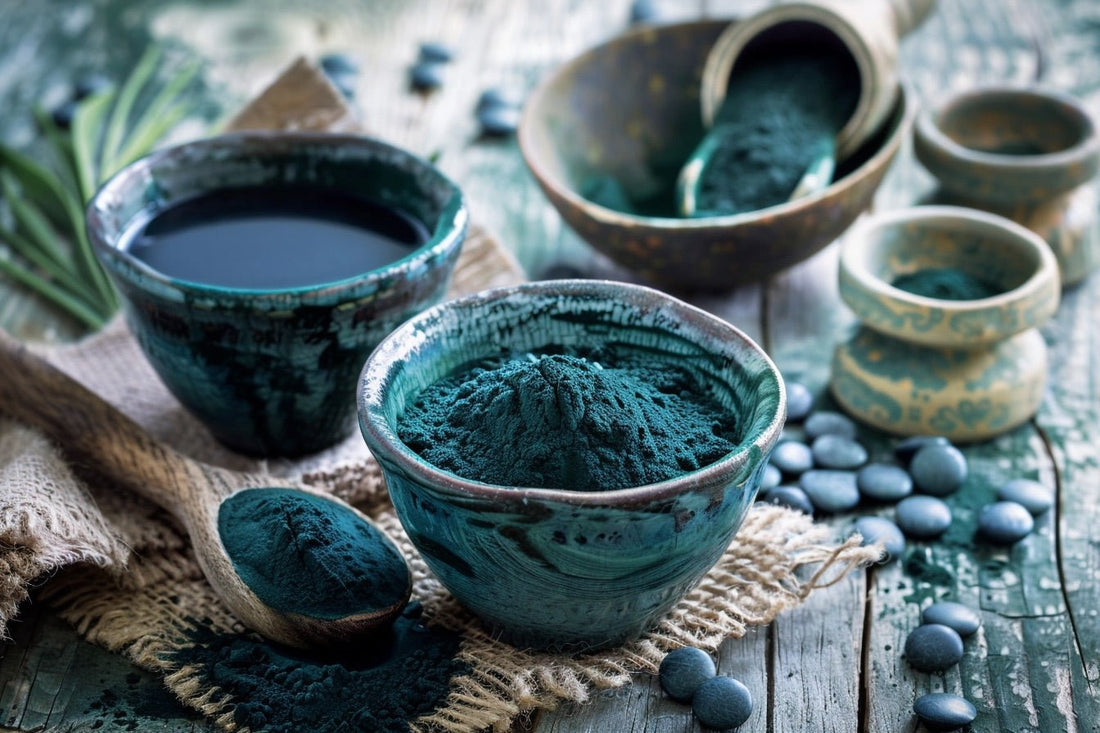
What is Blue Spirulina?
Share
What is Blue Spirulina?
In the realm of superfoods and dietary supplements, blue spirulina has gained notable attention for its vibrant color and potential health benefits. But what exactly is blue spirulina, and why has it become so popular? In this blog, we will explore what blue spirulina is, its nutritional profile, health benefits, how it can be incorporated into your diet, and any potential considerations to keep in mind.
Blue spirulina, often referred to as "blue-green algae," is a type of cyanobacteria, which is a microscopic, blue-green organism found in both fresh and saltwater. Unlike green spirulina, which is the whole algae, blue spirulina is an extract of phycocyanin, the pigment responsible for its vivid blue color. Phycocyanin is not only aesthetically appealing but also boasts a range of health-promoting properties.
Nutritional Profile of Blue Spirulina
Blue spirulina is celebrated for its dense nutrient content. Although it is primarily consumed in smaller quantities, it packs a powerful nutritional punch. Here’s a breakdown of its key components:
- Protein: Blue spirulina is rich in protein, containing all essential amino acids, making it a complete protein source.
- Vitamins: It is a good source of vitamins B1 (thiamine), B2 (riboflavin), and B3 (niacin), which are crucial for energy production and overall cellular function.
- Minerals: Blue spirulina provides a variety of minerals, including iron, magnesium, and potassium, which are vital for numerous bodily processes.
- Antioxidants: The phycocyanin pigment itself is a potent antioxidant, helping to combat oxidative stress and inflammation.
- Essential Fatty Acids: It contains small amounts of omega-6 and omega-3 fatty acids, which are important for brain health and inflammation regulation.
Health Benefits of Blue Spirulina
The consumption of blue spirulina can offer several health benefits, thanks to its rich nutritional profile:
- Anti-inflammatory and Antioxidant Properties: Phycocyanin, the primary pigment in blue spirulina, has strong antioxidant properties that help neutralize harmful free radicals in the body. This can reduce oxidative stress and inflammation, potentially lowering the risk of chronic diseases.
- Boosts Immune System: The various vitamins, minerals, and antioxidants in blue spirulina can help strengthen the immune system, making it more efficient in fighting off infections and diseases.
- Supports Muscle Strength and Endurance: The high protein content in blue spirulina supports muscle repair and growth, making it a popular supplement among athletes and fitness enthusiasts. Additionally, it may enhance endurance and reduce exercise-induced fatigue.
- Detoxification: Blue spirulina has natural detoxifying properties, helping to remove toxins from the body. It can bind to heavy metals and other harmful substances, promoting their excretion.
- Enhances Brain Health: The presence of essential fatty acids, along with the antioxidant properties, supports brain health, potentially improving cognitive function and protecting against neurodegenerative diseases.
How to Incorporate Blue Spirulina into Your Diet
Incorporating blue spirulina into your diet is relatively easy and can be a fun way to add a nutritional boost to your meals. Here are some simple ideas:
- Smoothies and Juices: Add a teaspoon of blue spirulina powder to your favorite smoothie or juice. It will not only enhance the nutritional value but also give it a vibrant blue hue.
- Baked Goods: You can mix blue spirulina into the batter for pancakes, muffins, or even bread for a fun and nutritious twist.
- Yogurt and Smoothie Bowls: Sprinkle blue spirulina powder over your yogurt or smoothie bowl for an eye-catching and healthy topping.
- Energy Balls and Bars: Incorporate blue spirulina into homemade energy balls or bars for a nutrient-dense snack.
- Lattes and Teas: Create a blue spirulina latte by blending the powder with milk and a sweetener of your choice. It can also be added to herbal teas for an added boost.
Considerations and Potential Side Effects
While blue spirulina is generally considered safe for most people, it is important to keep a few considerations in mind:
- Quality and Source: Ensure you are purchasing high-quality blue spirulina from reputable sources to avoid contamination with toxins or heavy metals. Organic and certified products are usually a safer choice.
- Dosage: Stick to the recommended dosage on the product label. While spirulina is beneficial, excessive intake can cause digestive issues or other adverse effects.
- Allergies: If you have a history of allergies to algae or seaweed, consult with a healthcare provider before incorporating blue spirulina into your diet.
- Medical Conditions: Individuals with certain medical conditions, such as autoimmune diseases or phenylketonuria (PKU), should seek medical advice before using blue spirulina.
Conclusion
Blue spirulina is a versatile and nutrient-rich superfood that can offer a range of health benefits, from boosting the immune system to enhancing brain health. Its vibrant color and potent nutritional profile make it an appealing addition to various recipes and dietary routines.
As with any supplement, it is important to choose high-quality products and consume them in moderation to reap the maximum benefits while minimizing potential risks. Whether you are a fitness enthusiast, a health-conscious individual, or someone looking to add a splash of color to your meals, blue spirulina might just be the superfood you need.
